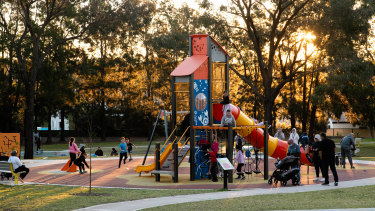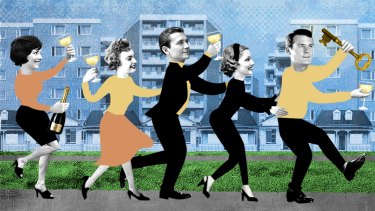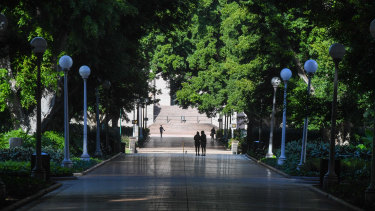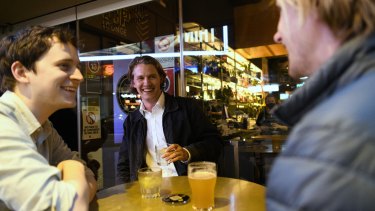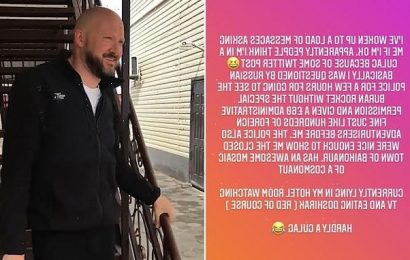For our free coronavirus pandemic coverage, learn more here.
There were times I wanted to torch the playground.
This was not the playground’s fault. The playground was obviously created by thoughtful people who like children and understand them.
It is canopied with a shade cloth, fringed with trees and flanked by lawns where, in happier times, locals had lolled.
A crowded playground in Greenacre during Sydney lockdown. Credit:Janie Barrett
But lockdown turned the playground at the end of the street into a prison. I particularly cursed the urban designer who had furnished it with a zipline.
Little kids love ziplines. Little kids can’t play on them without parental help. They need a tall person, an adult, to draw back the pulley, help them clasp the handle, and push them.
Then push them again. And again. And again. Annnnnd again.
The zipline and its Sisyphean cycle became representative of the lockdown.
They told us to focus on small pleasures.
But they never told us how tedious those pleasures could become, how those pleasures could become leached of pleasure.
But in the lockdown, everything is relative, and complaining was not only boring, it was self-indulgent.
There was always someone worse off, and it was during the lockdown we realised how very bad “worse off” could be.
Illustration: Dionne GainCredit:
There were friends with dying parents interstate. There were friends with cancer. There were friends with special needs kids at home. There were friends with marriages that teetered then crashed.
And that was just in the inner circle. No need, then, to watch the news to hear of wider human misery. I started switching off any time a ventilator was shown on screen. I muted anyone in scrubs. I didn’t want to hear about it. A loss of empathy or a survival mechanism? At times the two things became the same thing.
Looking at Melbourne, we New South Welshmen knew we should be thankful for our playgrounds, ziplines and all.
In the southern capital, a place with worse weather and worse case numbers, they had closed the playgrounds, a miserable act with obscure health benefits.
They taped them up like crime scenes, a visual representation of the public health message we were all forced to swallow: the things that used to give you pleasure, are now dangerous.
Other people were risky. You must draw away from them, fearing what they might give you, or what you might give them.
Playing, gathering, hugging, eating, dancing or singing together – all of it could be deadly.
What could be more cruel than telling human beings – who have evolved as the planet’s superior life form due to our ability to co-operate – to avoid each other?
Maybe the lockdown was good times for introverts, but still, all the introverts I know were online a hell of a lot.
The online thing seemed to expand and squeeze our solitude at the same time.
We couldn’t see other people or talk to them properly, with conversational pauses, body language and smiles doing the work of words.
Instead, we were in constant touch with a large array of people, some of them strangers, through WhatsApp group chats, Twitter, Instagram and Facebook.
This was exhausting in its own way, because while we were always communicating, we had no room to commune.
Now we are allowed to see each other again, many of us find it tiring, like walking under a harsh sun after months in a basement. It hurts the eyes. There is an adjustment.
The homeschoolers had it hard. It seemed like a giant cosmic chuckle to expect parents to take on the work of supervising their children’s education while also doing salaried work as usual.
At my house, it was the craft projects that broke mummy.
For women, who bore the brunt of the remote learning, and whose household work (studies showed) increased at a greater proportion than men’s, it was a joke. They were the punchline.
Which of the politicians canting about sacrifice and togetherness has ever overseen the construction of a diorama on a desolate Tuesday afternoon, or attempted to navigate Google classroom?
At my house, it was the craft projects that broke mummy.
Again, the reminder that we had it good. What about the kids who had no parent willing to be brought to tears by craft?
Notifications to authorities of suspected child abuse fell during lockdown. What about all those kids who needed to get out of the house to be safe? Their predicament was the opposite of others’. We didn’t hear about them. That’s the whole point.
The empty streets were eerie, but also a symbol of how successful we were at our project. For those of us who liked to walk the spooky streets, it was lonely but also interesting. It felt a little like the world was yours, if only for a little while, and that wasn’t all bad.
In my neighbourhood, we talked over our back fences and in our front yards, sometimes with a glass in hand, in ways that flirted with the idea of gathering.
But there was always a wall between us, literally.
Now the world is thronging up again. A recent trip to the shopping mall reminded me how awful shopping malls are. Why did we ever do this? Surely it makes no sense to ever buy anything you can’t buy online. Not anymore.
The queues outside Kmart at midnight the day before restrictions were lifted, tell another story, however.
Now that we can shop, gather and travel again, will we snap back? Or have we been bent so out of shape that is impossible?
Public transport is busy again, but business districts and the CBD are still on the ghostly side. “There are fewer options for lunch!” you think, and then you remember that’s because there are so many small businesses that didn’t survive.
Empty streets: business districts and the CBD are still on the ghostly side. Credit:Peter Rae
What has happened to all those people? Where are they now?
Children are back at school, but the school gate chat is masked and socially distant, and lots of children and teenagers are having difficulties readjusting, as though they have forgotten how to be.
The school communities, like the church, club and sporting communities, had to go online and are now desiccated; Humpty Dumpty-like and hard to put back together.
For those of us who missed the theatre, live shows, the joy of being entertained in a crowd, those pleasures are creeping back.
God knows we need them to return. The arts sector was decimated and then largely forgotten by a government that laments the loss of a single fossil-fuel job but seemed impervious to actors, musicians, or lighting technicians being laid off.
But how will the performers feel when they look out onto a masked audience? How will they know we are smiling? There will be no full houses because most theatres are not going back to full capacity, and no box offices because it’s all contactless now.
Going back to the pub, the bar, the restaurant, feels exciting. Everyone is a chatterbox. It’s as though we have forgotten the rules of engagement and want to blurt out our excitement at just being together. After whiling away so many formless hours, we have no time to waste!
It is thrilling to pay a bill, it is thrilling to order another round, it is thrilling to gulp in the stories of your friends and leave no topic uncovered.
Friends share a drink and a laugh at the Kings Cross Hotel.Credit:Rhett Wyman
But still, the streets are not quite the same.
People are still not out in the numbers they were, and plans are still on hold. Many plans have been given up altogether.
They say the Spanish flu pandemic brought on the abandon of the Roaring Twenties. Give us some of that abandon, I say.
Did the lockdown transform us? Certainly, we can’t go back to how we were.
Together with climate change and Chinese expansionism, it feels like the pandemic is just one of the cluster of real, grown-up problems humanity now faces. They are all such blastedly existential threats!
Yes, the Cold War was bad, but it was a more controllable risk than the ferocity of nature, and, importantly, nuclear war never broke out.
An article in The Atlantic this week noted that Americans, ahead of us in terms of pandemic stages, are still suffering anxiety and depression at high rates, despite the easing of lockdown and restrictions.
One expert quoted talked about “the burden of accumulated adversity” which acts like an ankle weight on the human psyche, geared though we are for resilience and adaptation.
I don’t know if anything has been learned through the lockdowns, or if we have changed fundamentally. I think we have an awareness of fragility that we didn’t before.
This shows up in spikiness and insecurity in public discourse.
It’s as though we now have a sense of unease, borne from the knowledge of how quickly things can be taken from us.
A particular pre-pandemic memory I returned to during lockdown was a dance floor, early in the morning after a 2019 Christmas party. Dancing. Sweating, hugging, sharing drinks.
Jumping around in a crowded, subterranean space, thinking I should really go home (responsibility always knocking in the back of the mother-brain) but resisting the thought.
So many times since, I have thanked my past self for not going home at a sensible hour that night.
It made me feel so much better about pushing my daughter on the zipline for the umpteenth time, an activity I continue to do, and one which now, strangely, I enjoy, for the simple reason that it makes her happy.
Twitter: @JacquelineMaley
Most Viewed in National
From our partners
Source: Read Full Article
